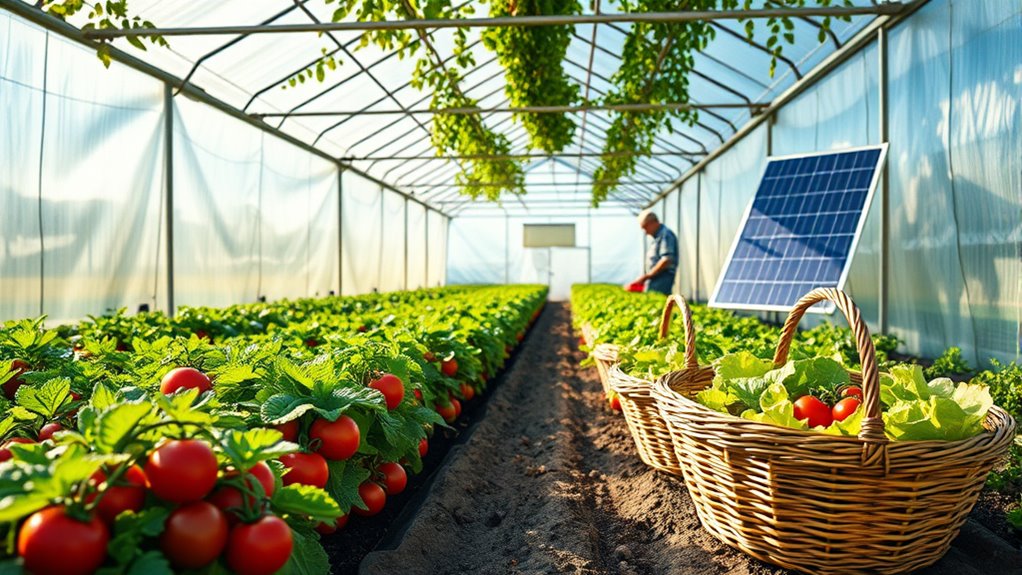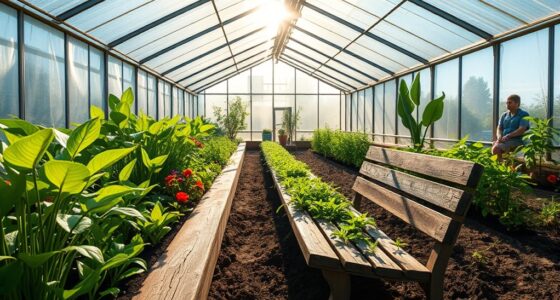Greenhouse farming offers you year-round production, boosting crop yields and quality while providing premium pricing opportunities. You'll experience stability in income through reliable yields and reduced financial risks. Although initial investments can be substantial, long-term costs can be managed with energy-efficient practices. Plus, innovations in technology enhance operational efficiency and promote environmental sustainability. Keep exploring to discover how these benefits can reshape your approach to modern agriculture.
Key Takeaways
- Greenhouse farming ensures year-round production, stabilizing income and reducing dependency on seasonal fluctuations in crop availability.
- Controlled environments enhance crop yields and quality, optimizing resource usage and minimizing losses through advanced technology.
- Premium pricing opportunities arise from organic certifications and high-value crops, boosting profitability and market demand.
- Initial investments can be offset by long-term energy-efficient practices that reduce operational costs and improve returns over time.
- Technological innovations promote environmental sustainability, decreasing water usage and minimizing waste while enhancing operational efficiency.
Year-Round Production Capabilities

As greenhouse farming allows you to produce crops year-round, it guarantees a consistent supply of fresh produce that meets consumer demand, regardless of the season. This flexibility helps you adapt to market trends by adjusting your crop varieties and planting schedules. By reducing dependency on seasonal fluctuations, you enhance your economic stability and create opportunities to tap into niche markets. With extended growing seasons, you can cultivate crops beyond their natural periods, maximizing your yield potential. This year-round capability not only stabilizes your income streams but also positions you for consistent profitability. Embracing greenhouse farming means you're not just growing food; you're building a resilient agricultural business that thrives in changing market conditions, while also benefiting from consistent crop quality throughout the year. Additionally, the emphasis on personal and community resilience in your farming practices can foster stronger connections with local consumers, further enhancing your market reach. Including whole foods in your crop selection can also elevate the nutritional value of your produce, appealing to health-conscious consumers. Furthermore, utilizing renewable energy technologies in greenhouse operations can further reduce operational costs and enhance sustainability.
Increased Crop Yields and Quality
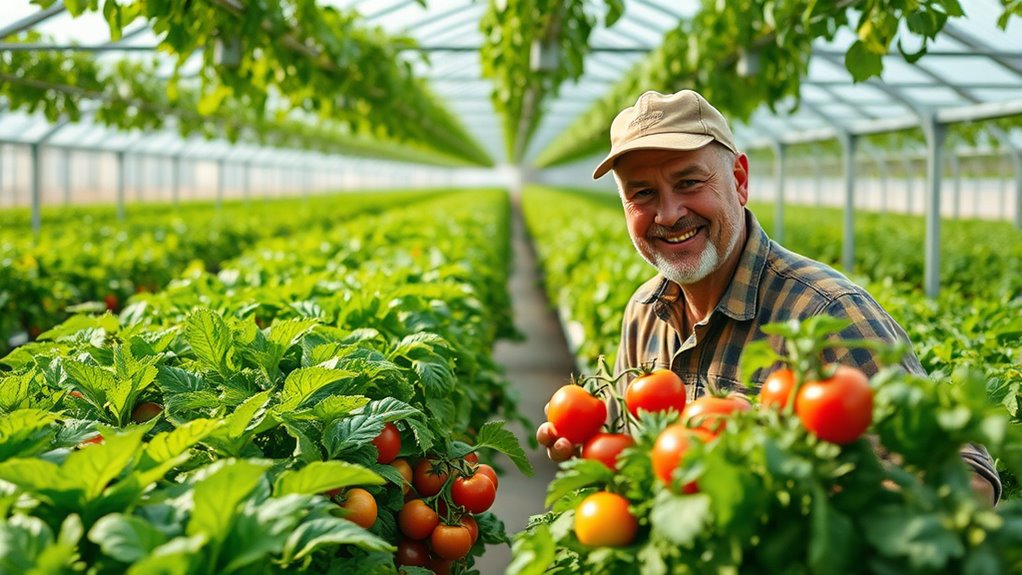
Greenhouse farming not only guarantees year-round production but also markedly boosts crop yields and quality. By providing ideal temperature and humidity, you create an environment that enhances plant growth. You'll find that resource efficiency improves, as controlled settings help you use water and nutrients more effectively. Additionally, reduced pesticide needs lead to healthier crops, while environmental controls protect against diseases, minimizing losses. The advanced technology in modern greenhouses, like sensors and automation, maximizes your crop growth. As a result, you can enjoy better flavor and nutritional content in your produce, ensuring consistency in quality and freshness. This all translates to higher productivity and healthier crops, benefiting both you and your consumers. Moreover, sustainable farming practices supported by greenhouse farming help in preserving natural ecosystems while enhancing overall crop performance. Furthermore, the use of a backyard greenhouse can greatly facilitate personal gardening efforts and improve access to fresh produce. Additionally, the integration of solar energy solutions can significantly reduce operational costs by utilizing renewable resources for energy needs. Regular monitoring of water sources is essential to ensure that your greenhouse plants receive adequate hydration for optimal growth.
Premium Pricing Opportunities

Many greenhouse growers discover that premium pricing opportunities arise from various strategies and market trends.
By obtaining organic certification, you can boost your prices by up to 30%. High-value crops like microgreens and specialty herbs often command higher market prices due to their unique appeal. You can stand out from competitors by offering exotic varieties, especially during winter when seasonal produce is scarce. Additionally, exporting high-quality crops, such as orchids, can yield significant profits. Targeting niche markets, launching subscription services, and hosting workshops can enhance your brand and justify premium pricing. Leveraging consumer preferences for sustainability and local produce also helps you capture that premium market, ensuring your greenhouse thrives economically. Furthermore, engaging in community-supported agriculture can strengthen ties with local consumers, ultimately contributing to your premium pricing strategy. Incorporating elements of traditional healing practices in your marketing can also resonate with customers who value cultural connections to their food sources. Moreover, understanding the importance of fresh, unprocessed ingredients can help you create appealing products that attract health-conscious consumers. Additionally, offering juice cleanses can cater to health-conscious buyers seeking detoxification and wellness benefits, enhancing your product range and market appeal.
Stability in Income and Market Demand
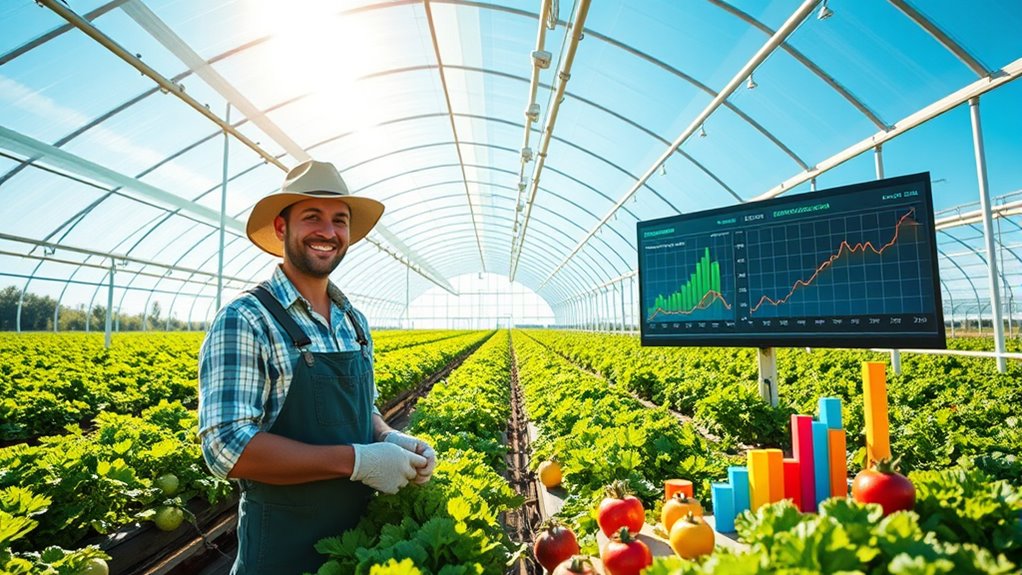
The premium pricing opportunities you've explored set the stage for another significant advantage of greenhouse farming: stability in income and market demand.
With year-round production, you can reduce income fluctuations caused by seasonal changes and guarantee consistent yields, minimizing risks from unpredictable weather. This reliability allows you to fulfill constant market demands for fresh produce, securing long-term contracts with retailers. Additionally, greenhouse farming mitigates risks associated with unpredictable weather conditions, allowing for a more stable production cycle. Moreover, creating a holistic living environment through sustainable practices can enhance community engagement and support for local farmers. Recent studies indicate that implementing sustainable practices can significantly increase both crop yields and marketability. Greenhouse farming also provides opportunities for extended growing seasons, maximizing productivity beyond traditional growing periods.
Furthermore, consumer preferences are shifting towards locally sourced and sustainable options, aligning perfectly with your greenhouse practices. By diversifying crop offerings, you can cater to niche markets and mitigate seasonal demand fluctuations.
Ultimately, this stability not only enhances your profitability but also reduces financial risks, creating a solid foundation for your greenhouse farming venture.
Initial Investment and Long-Term Costs
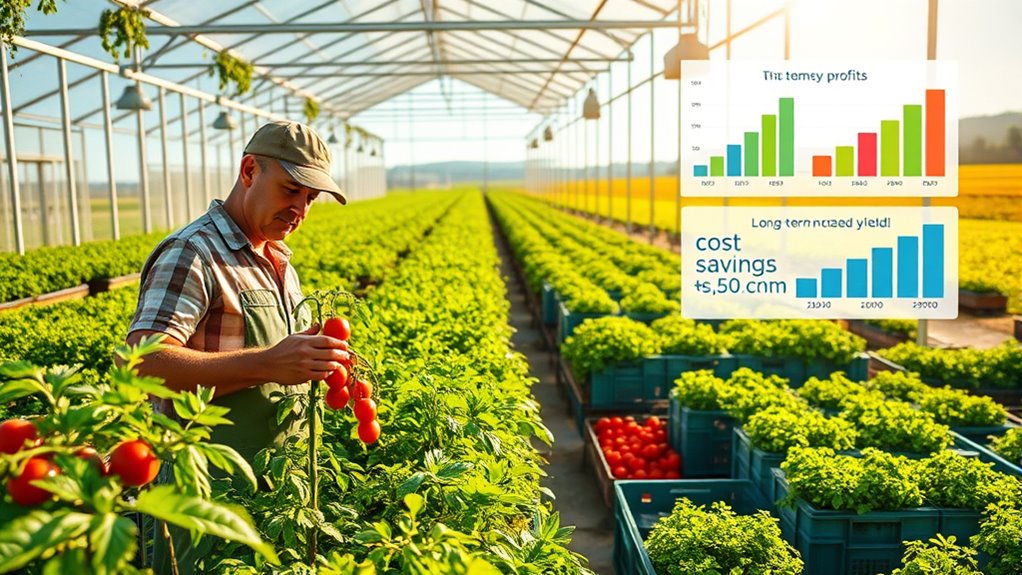
When considering greenhouse farming, understanding the initial investment and long-term costs is essential for your financial planning.
You'll face initial expenses like the greenhouse structure, which can range from $5,000 to $30,000. Depending on your location, land acquisition might set you back $500 to $50,000. Equipment and climate control systems can add another $5,000 to $25,000. Initial costs vary based on greenhouse size and type, so it's crucial to assess your specific needs before making a decision. Additionally, evaluating air quality considerations can impact the success of your crops and overall yields. Implementing energy-efficient practices, such as renewable energy sources, can also help reduce long-term operational costs. Moreover, investing in high-performance units like heat pumps can significantly enhance climate control efficiency.
Long-term costs include energy bills, which can run between $100 and $600 monthly, along with ongoing expenses for seeds, fertilizers, and maintenance. Efficient practices can help manage these costs, but it's vital to keep location, technology, and crop selection in mind as they greatly influence your overall budget.
Planning wisely can enhance your returns over time.
Enhancements in Operational Efficiency
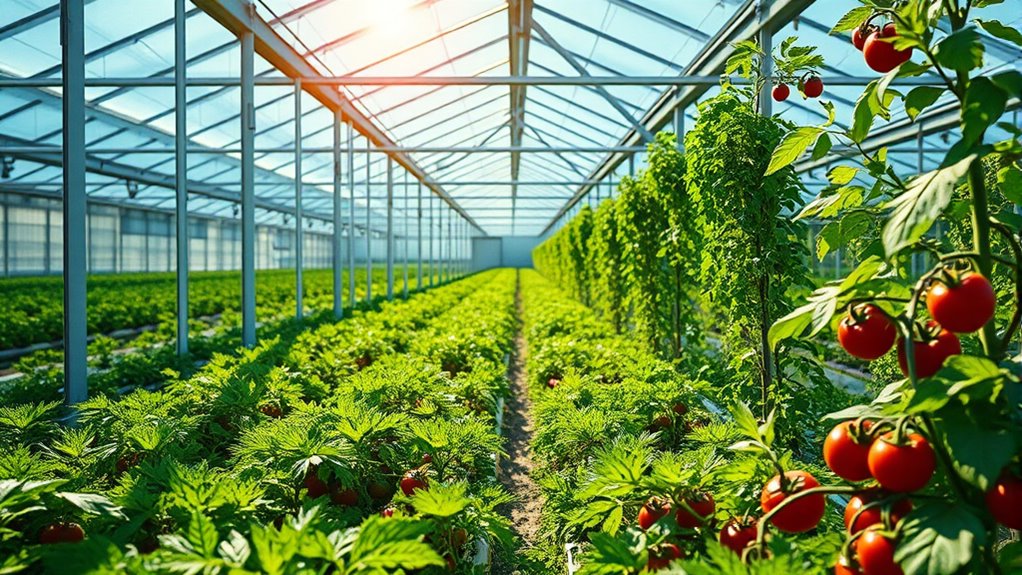
As you explore greenhouse farming, enhancing operational efficiency becomes essential for maximizing productivity and profitability.
Digital solutions, like the Argos software, streamline everything from seedling cultivation to shipping logistics, helping you save time and energy.
Digital solutions, such as Argos software, optimize seedling cultivation and shipping logistics, enhancing time and energy efficiency.
With modern inventory management systems, you can track plant stock in real-time, minimizing waste and unnecessary energy consumption. In addition, efficient management reduces energy use by optimizing operations. Furthermore, applying strategic planning can ensure that resources are aligned effectively for optimal outcomes. Moreover, implementing predictive modeling allows you to anticipate future crop yields and adjust your strategies accordingly. High cultural intelligence is vital for understanding diverse consumer needs and tailoring your approach to different markets.
Advanced analytics allow you to pinpoint ideal planting times and predict demand, ensuring you have the right stock available.
Automation reduces labor costs and maintains consistency, addressing shortages effectively.
Real-time monitoring enables you to respond swiftly to changes in demand or environmental conditions, ultimately boosting your operational efficiency and ensuring a more profitable greenhouse operation.
Market and Consumer Advantages
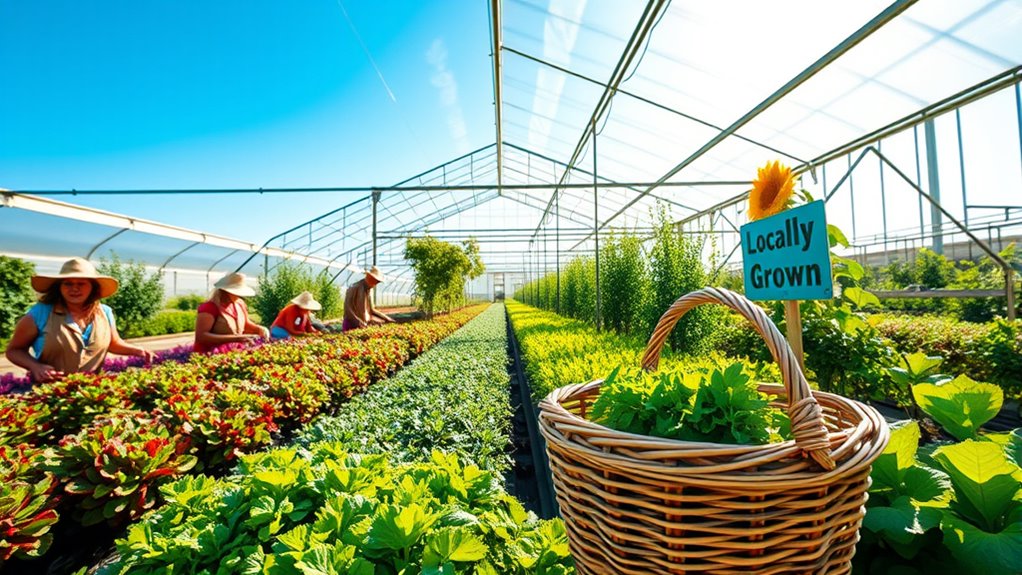
Greenhouse farming offers numerous market and consumer advantages that can greatly enhance profitability and sustainability. You can produce crops year-round, ensuring a steady supply of fresh produce, which meets market demands consistently. This stability reduces income fluctuations and gives you a competitive edge, allowing you to command higher prices for premium quality crops. Additionally, greenhouses enable you to diversify crop options and cater to niche markets, providing unique products to consumers. Buyers appreciate the consistent quality and freshness of greenhouse-grown produce, which often has a longer shelf life. Furthermore, year-round production ensures that you can cultivate crops continuously, thereby maximizing your profit potential throughout the year. This method of farming also allows for improved color accuracy in the quality of produce, as consistent growing conditions lead to better crop health and appearance. Moreover, adopting new technologies in greenhouse farming can further enhance operational efficiency and yield. Additionally, greenhouse farming can support sustainable eating habits, as it reduces the carbon footprint associated with transporting food over long distances.
Environmental Sustainability Considerations
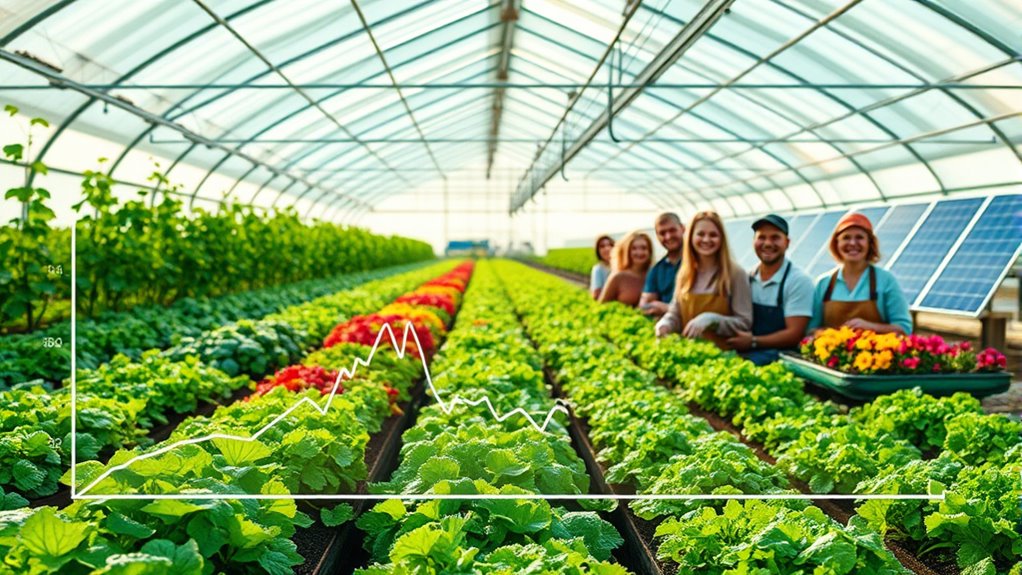
While many farming methods contribute to environmental degradation, greenhouse farming stands out for its ability to promote sustainability.
You'll appreciate how greenhouses drastically reduce water evaporation by 20-40%, cutting down irrigation needs. By integrating renewable energy sources like solar panels, you lessen reliance on fossil fuels and lower operational costs. Additionally, greenhouse area in Europe is estimated at 210,000 hectares, showcasing its widespread adoption and potential for sustainability. The use of Gold IRAs in investing also reflects a growing trend towards sustainable practices in financial portfolios. Moreover, utilizing solar energy in greenhouse operations can lead to substantial energy bill reductions while maintaining optimal growing conditions. Incorporating self-watering planters can further enhance water efficiency in greenhouse settings.
Plus, efficient waste management practices, such as recapturing water and fertilizers, prevent harmful runoff into ecosystems. With hydroponic and aeroponic systems, you can minimize the use of water, fertilizers, and pesticides.
Utilizing recyclable materials for construction not only lessens environmental impact but also promotes material sustainability.
Ultimately, greenhouses protect crops from pollutants, ensuring cleaner produce and supporting biodiversity, making them a responsible choice for modern agriculture.
Technological Innovations in Greenhouse Farming

Technological innovations in greenhouse farming are revolutionizing the way you grow crops, making the process more efficient and sustainable.
Automated systems adjust ventilation and heating in real-time, optimizing plant growth while reducing labor costs. Automated irrigation systems deliver precise water directly to plant roots, further enhancing resource efficiency. Additionally, implementing energy-efficient technology can significantly lower greenhouse energy costs.
Precision agriculture employs sensors and data analytics to enhance resource use and crop yields.
Vertical farming, utilizing hydroponics and aeroponics, maximizes space and efficiency.
Artificial Intelligence (AI) monitors conditions, identifies diseases, and recommends treatments, ensuring healthy plants.
Robotics automate tasks like planting and harvesting, boosting productivity.
With energy-efficient materials and controlled irrigation, you conserve water and energy.
These advancements allow for year-round production, independent of weather, ultimately enhancing your profitability while promoting sustainable practices.
Frequently Asked Questions
What Types of Crops Are Best Suited for Greenhouse Farming?
When considering crops for greenhouse farming, you'll want to focus on those that thrive in controlled environments.
Tomatoes and peppers are popular due to high demand. Fast-growing options like cucumbers and microgreens can boost your returns quickly.
For year-round production, strawberries and herbs are excellent choices. If you're looking to cater to market demand, mushrooms and ginseng can be quite profitable.
Choose crops that align with your goals and local market needs.
How Do Greenhouses Affect Local Job Opportunities?
Imagine a bustling urban landscape transformed by vibrant greenhouses, each one a hub of activity.
You'll find diverse job opportunities sprouting up, from skilled growers to greenhouse managers. As you walk by, you notice local residents engaged in full-time roles, enhancing community ties.
With internships available, students can gain hands-on experience. Each job not only cultivates plants but also nurtures local economies, rooting deeper connections between the greenhouse and the community.
What Financing Options Are Available for Greenhouse Construction?
When considering financing options for greenhouse construction, you've got several choices.
Bank loans offer competitive rates, while government grants can support eco-friendly projects.
Specialized agricultural loans cater specifically to your needs, and equipment financing lets you spread out costs.
You might also explore crowdfunding or peer-to-peer lending for alternative funding sources.
Additionally, look into green bonds or a home equity line of credit to utilize your home's value for financing.
How Can Farmers Transition From Traditional to Greenhouse Farming?
Shifting from traditional to greenhouse farming is like stepping from the sunlit field into a climate-controlled haven.
You'll start by evaluating land suitability and market demand, ensuring your foundation's solid.
Next, familiarize yourself with sustainable practices and technology that'll enhance your operations.
As you design and construct your greenhouse, implement energy-efficient solutions.
Finally, don't forget to engage with your community and continuously adapt to market changes for lasting success.
What Are Common Challenges Faced in Greenhouse Farming?
In greenhouse farming, you'll face several common challenges.
First, managing temperature and humidity is essential to prevent crop damage and disease. You'll also need to guarantee proper air circulation to avoid stagnant conditions.
Pests and diseases can thrive in this environment, requiring vigilant monitoring.
Additionally, high initial investments and ongoing operational costs can strain your resources.
Finally, adapting to market fluctuations and regulatory requirements can complicate your greenhouse operations further.
Conclusion
In the end, who would've thought that growing plants in a glass box could be so profitable? You might imagine it's just for hobbyists, but greenhouse farming offers you year-round production, higher yields, and even premium prices. It's almost like the plants are paying you back for all that TLC! Plus, with tech innovations and sustainability in mind, you're not just making money; you're saving the planet too. Ironically, the future of farming might just be under glass!
